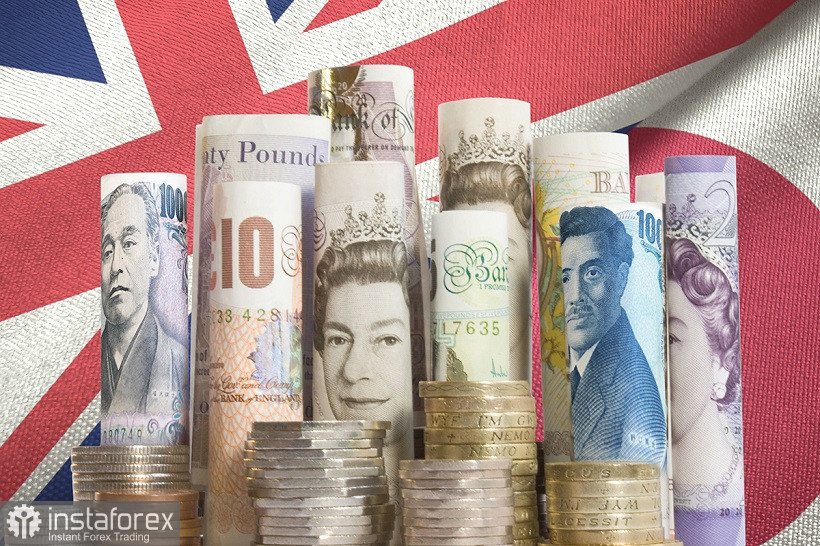The GBP/JPY pair shows a pronounced northern trend: in two weeks, the pound has strengthened by more than a thousand points. Therefore, the current price decline should be considered a forced correction after a rapid, prolonged price increase. The British currency is quite cautious when paired with the dollar, but it dominates when paired with the yen. Traders were not intimidated by political factors (when clouds gathered over Boris Johnson), weak macroeconomic reports (in particular, on UK GDP growth), or experts' doubts about the further "aggressiveness" of the British regulator. All these factors were virtually ignored: the pair grew steadily, conquering new peaks. Today, the pair has updated the six-year price maximum, having come close to the boundaries of the 169th figure. However, the buyers of GBP/JPY did not dare to storm the resistance level of 169.00 – in this area, traders recorded profits, thereby extinguishing the northern impulse.

Nevertheless, it is impossible to talk about a trend reversal. The divergence of the rates of the Bank of Japan and the Bank of England will continue to push the pair up, so the corrective decline can be used as an excuse to open long positions. Recent events and comments by Central Bank officials suggest that the British regulator will maintain its course to tighten monetary policy at least until the end of the year, despite certain doubts voiced at the last meetings of the Bank of England. According to most experts, the Central Bank will raise the rate by 25 basis points at each meeting this year. As a result, in December, the rate will rise to a two percent level. The prospects look rather vague, but in the context of the development of the northern trend of GBP/JPY, this is not so important. The main thing is that concerns about a possible pause on the part of the English regulator have decreased in the market. More recently, this scenario was discussed quite actively, especially after the May meeting of the Bank of England.
Summing up the results of the last meeting, Andrew Bailey made it clear that the Central Bank, by and large, is facing a difficult choice: either the regulator raises the rate further at an aggressive pace, struggling with inflationary growth (but at the same time pushing the economy into recession), or "resigns" with a further increase in the consumer price index, hoping for an increase in GDP or at least stagnation. After a series of disappointing releases (weak PMI indices, a slowdown in UK GDP growth in the first quarter amid increased price pressure), some experts suggested that after the August increase, the Central Bank will take a break for an indefinite period. However, recent statements by representatives of the British Central Bank leveled these concerns. The members of the Bank of England will not resort to aggressive rate hikes, but they will not resort to any pauses in the process of tightening monetary policy: they will withstand a 25-point rate increase until the end of this year.
Such conclusions push the pair up. Moreover, the Bank of Japan takes the opposite position, maintaining a "dovish" attitude. That is why the yen ignores Japanese macroeconomic statistics, even though key economic indicators have recently been released in the "green zone". For example, at the end of May, a fairly strong inflation report was published: all components of the release exceeded the forecast values. The overall consumer price index in Japan continued its upward movement, rising to 2.5%, with a forecast of growth up to 1.5%. This is the strongest growth rate since November 2014. The consumer price index excluding fresh food prices (the Central Bank's most monitored inflation indicator) also showed positive dynamics, rising to 2.1%. The growth rate was the highest since March 2015.
However, the head of the Bank of Japan believes that the increase in inflation is temporary and unstable. At its last meeting, the Japanese regulator again declared its commitment to the accommodation policy. In one of his speeches, the head of the Central Bank, Haruhiko Kuroda, repeated several times the thesis that the Bank of Japan would not follow the Federal Reserve in the context of raising rates. And although this week the head of the Central Bank was concerned about the sharp devaluation of the yen, he reiterated his readiness to soften the parameters of monetary policy.
Thus, taking into account the recent comments of the representatives of the Central Bank of Britain and Japan, it can be assumed that the northern trend of GBP/USD has not exhausted its potential. The divergence of the regulators' positions will continue to push the pair up, at least to the resistance level of 169.00.
All this suggests that despite the record 20-year rise of GBP/JPY, the yen is likely to continue to fall in price. On all timeframes (from the four-hour chart and above), the price is located on the upper line of the Bollinger Bands indicator, as well as above all the lines of the Ichimoku indicator, which formed a bullish "Line Parade" signal. The nearest northern targets are 168.50 and 169.00.
 English
English 
 Русский
Русский Bahasa Indonesia
Bahasa Indonesia Bahasa Malay
Bahasa Malay ไทย
ไทย Español
Español Deutsch
Deutsch Български
Български Français
Français Tiếng Việt
Tiếng Việt 中文
中文 বাংলা
বাংলা हिन्दी
हिन्दी Čeština
Čeština Українська
Українська Română
Română

